check engine PEUGEOT 308 SW BL 2010 User Guide
[x] Cancel search | Manufacturer: PEUGEOT, Model Year: 2010, Model line: 308 SW BL, Model: PEUGEOT 308 SW BL 2010Pages: 336, PDF Size: 21.2 MB
Page 93 of 336

i
91
ACCESS
The key cannot be removed from
the lock until the cap is put back on
the tank.
Opening the cap may cause an in-
rush of air. This vacuum, which is
perfectly normal, is caused by the
sealing of the fuel system.
FUEL TANK
Capacity of the tank: approximately
60 litres.
To fi ll the tank safely:
�)
it is essential that the engine is
switched off,
�)
open the fuel fi ller fl ap,
�)
insert the key in the cap, then turn it
to the left,
When fi lling is complete:
�)
refi t the cap,
�)
turn the key to the right, then remove
it from the cap,
�)
close the fl ap.
�)
remove the cap and secure it on the
hook, located on the inside of the
fl ap,
�)
fi ll the tank, but do not continue
after the 3rd cut-off of the nozzle
;
this could cause malfunctions.
Low fuel level
Filling
A label affi xed to the inside of the fl ap
reminds you of the type of fuel to be
used according to your engine.
More than 5 litres of fuel must be add-
ed in order to be registered by the fuel
gauge.
Operating fault
A fuel gauge malfunction is indicated by
the return of the fuel gauge needle to
zero.
Have it checked by a PEUGEOT dealer. When the low fuel level is
reached, this warning lamp
comes on on the instrument
panel, accompanied by an
audible signal and a message on the
multifunction screen. When it fi rst comes
on, you have approximately 6 litres
of
fuel remaining.
Until suffi cient fuel has been added, this
warning lamp comes on every time the
ignition is switched on, accompanied
by an audible signal and a message.
Depending on version, this audible sig-
nal and message are repeated with in-
creasing frequency as the level drops
towards "0"
.
Refuel as soon as possible to avoid run-
ning out of fuel.
If you run out of fuel (Diesel), refer also
to the "Checks" section.
Page 133 of 336
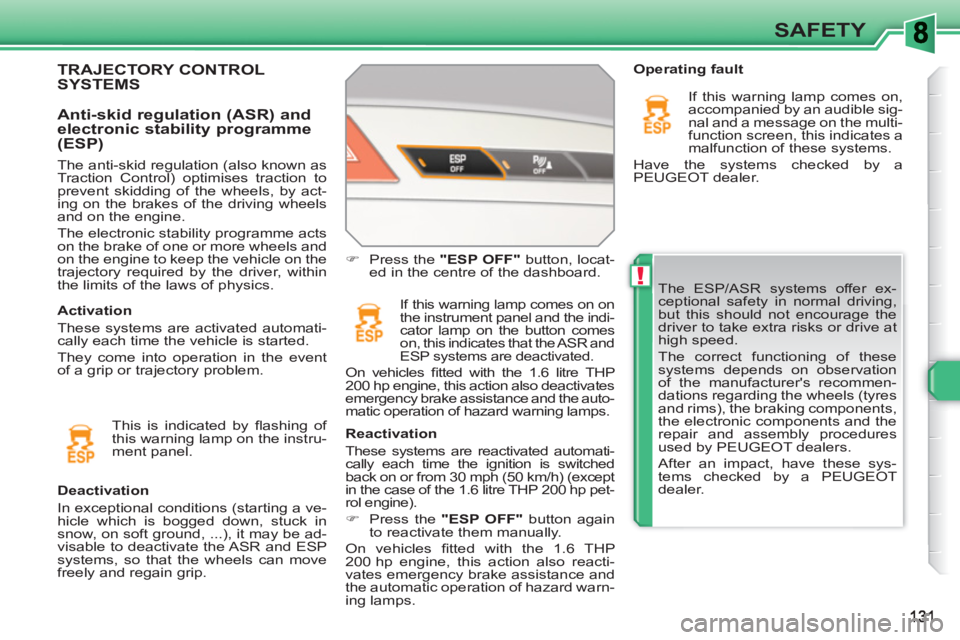
!
SAFETY
The ESP/ASR systems offer ex-
ceptional safety in normal driving,
but this should not encourage the
driver to take extra risks or drive at
high speed.
The correct functioning of these
systems depends on observation
of the manufacturer's recommen-
dations regarding the wheels (tyres
and rims), the braking components,
the electronic components and the
repair and assembly procedures
used by PEUGEOT dealers.
After an impact, have these sys-
tems checked by a PEUGEOT
dealer.
Deactivation
In exceptional conditions (starting a ve-
hicle which is bogged down, stuck in
snow, on soft ground, ...), it may be ad-
visable to deactivate the ASR and ESP
systems, so that the wheels can move
freely and regain grip.
�)
Press the "ESP OFF"
button, locat-
ed in the centre of the dashboard.
If this warning lamp comes on on
the instrument panel and the indi-
cator lamp on the button comes
on, this indicates that the ASR and
ESP systems are deactivated.
On vehicles fi tted with the 1.6 litre THP
200 hp engine, this action also deactivates
emergency brake assistance and the auto-
matic operation of hazard warning lamps.
Reactivation
These systems are reactivated automati-
cally each time the ignition is switched
back on or from 30 mph (50 km/h) (except
in the case of the 1.6 litre THP 200 hp pet-
rol engine).
�)
Press the "ESP OFF"
button again
to reactivate them manually.
On vehicles fi tted with the 1.6 THP
200 hp engine, this action also reacti-
vates emergency brake assistance and
the automatic operation of hazard warn-
ing lamps.
Operating fault
If this warning lamp comes on,
accompanied by an audible sig-
nal and a message on the multi-
function screen, this indicates a
malfunction of these systems.
Have the systems checked by a
PEUGEOT dealer.
TRAJECTORY CONTROLSYSTEMS
Activation
These systems are activated automati-
cally each time the vehicle is started.
They come into operation in the event
of a grip or trajectory problem.
Anti-skid regulation (ASR) and
electronic stability programme
(ESP)
This is indicated by fl ashing of
this warning lamp on the instru-
ment panel.
The anti-skid regulation (also known as
Traction Control) optimises traction to
prevent skidding of the wheels, by act-
ing on the brakes of the driving wheels
and on the engine.
The electronic stability programme acts
on the brake of one or more wheels and
on the engine to keep the vehicle on the
trajectory required by the driver, within
the limits of the laws of physics.
Page 136 of 336
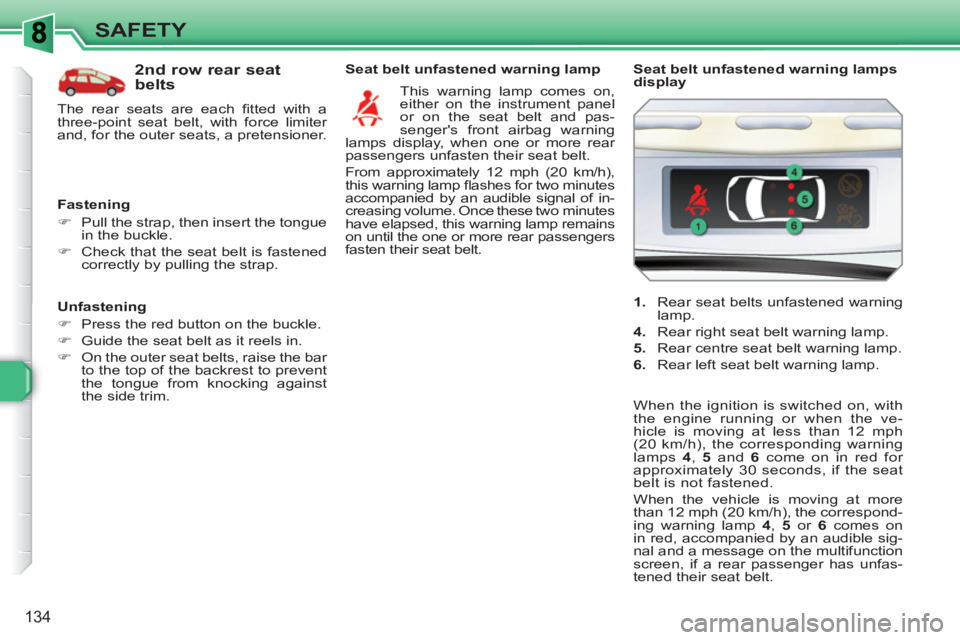
134
SAFETY
Unfastening
�)
Press the red button on the buckle.
�)
Guide the seat belt as it reels in.
�)
On the outer seat belts, raise the bar
to the top of the backrest to prevent
the tongue from knocking against
the side trim.
Seat belt unfastened warning lamp
This warning lamp comes on,
either on the instrument panel
or on the seat belt and pas-
senger's front airbag warning
lamps display, when one or more rear
passengers unfasten their seat belt.
From approximately 12 mph (20 km/h),
this warning lamp fl ashes for two minutes
accompanied by an audible signal of in-
creasing volume. Once these two minutes
have elapsed, this warning lamp remains
on until the one or more rear passengers
fasten their seat belt.
1.
Rear seat belts unfastened warning
lamp.
4.
Rear right seat belt warning lamp.
5.
Rear centre seat belt warning lamp.
6.
Rear left seat belt warning lamp.
Seat belt unfastened warning lamps
display
When the ignition is switched on, with
the engine running or when the ve-
hicle is moving at less than 12 mph
(20 km/h), the corresponding warning
lamps 4
, 5
and 6
come on in red for
approximately 30 seconds, if the seat
belt is not fastened.
When the vehicle is moving at more
than 12 mph (20 km/h), the correspond-
ing warning lamp 4
, 5
or 6
comes on
in red, accompanied by an audible sig-
nal and a message on the multifunction
screen, if a rear passenger has unfas-
tened their seat belt.
2nd row rear seat
belts
The rear seats are each fi tted with a
three-point seat belt, with force limiter
and, for the outer seats, a pretensioner.
Fastening
�)
Pull the strap, then insert the tongue
in the buckle.
�)
Check that the seat belt is fastened
correctly by pulling the strap.
Page 148 of 336

!!
i
146
DRIVING
Stopping the vehicle
Operating fault
With the ignition on, if this warn-
ing lamp comes on and AUTO
fl ashes, accompanied by an au-
dible signal and a message on
the multifunction screen, this indicates
a malfunction of the gearbox.
Have it checked by a PEUGEOT dealer.
It is essential to press the brake
pedal when starting the engine.
When parking, is it essential to ap-
ply the parking brake to immobilise
the vehicle, whatever the circum-
stances. When immobilising the vehicle,
with the engine running, it is es-
sential to place the gear lever in
neutral N
.
Before carrying out any work in the
engine compartment, check that
the gear lever is in neutral N
and
that the parking brake is applied. With the ignition on, if the warn-
ing lamp above and this warning
lamp come on, accompanied by
an audible signal and a message
on the multifunction screen, this indicates a malfunction of the hill start assist system.
Have it checked by a PEUGEOT dealer.
Sport function
�)
Following selection of the sequential
mode or automatic mode, press
button S
to activate the Sport
function which offers you a more
dynamic style of driving.
S
appears next to the gear en-
gaged on the instrument panel
screen.
�)
Press button S
again to deactivate
the function.
S
is then cleared from the instrument
panel screen.
The Sport function is deactivated
each time the ignition is switched off. Before switching off the engine, you can
choose to:
- move to position N
to engage
neutral,
- leave the gear engaged; in this
case, it will not be possible to move
the vehicle.
In both cases, it is essential that you ap-
ply the parking brake to immobilise the
vehicle. This warning lamp may also come on if
a door is opened.
Page 151 of 336

!
i
149
DRIVING
Stopping the vehicle
Before switching off the engine, you
can engage position P
or N
to place the
gearbox in neutral.
In both cases, apply the parking brake
to immobilise the vehicle.
Operating fault
When the ignition is on, the
lighting of this warning lamp,
accompanied by an audible sig-
nal and a message on the mul-
tifunction screen, indicates a gearbox
malfunction.
In this case, the gearbox switches to
emergency mode and is locked in 3rd
gear. You may feel a substantial knock
when changing from P
to R
and from N
to R
. This will not cause any damage to
the gearbox.
Do not exceed a speed of 60 mph
(100 km/h), local speed restrictions per-
mitting.
Have it checked by a PEUGEOT dealer.
This warning lamp may also come on if
a door is opened.
There is a risk of damage to the
gearbox:
- if you press the accelerator and
brake pedals at the same time,
- if you force the lever from
position P
to another position
when the battery is fl at.
Manual operation
�)
Select position M
for sequential
changing of the four or six gears.
�)
Push the lever towards the +
sign to
change up a gear.
�)
Pull the lever towards the -
sign to
change down a gear.
D
disappears and the gears
engaged appear in succes-
sion on the instrument panel.
In the event of under-revving
or over-revving, the gear se-
lected fl ashes for a few seconds, then
the actual gear engaged is displayed. If the lever is not in position P
,
when the driver's door is opened or
approximately 45 seconds after the
ignition is switched off, an audible
signal is heard and a message ap-
pears.
�)
Return the lever to position P
;
the audible signal stops and the
message disappears.
It is only possible to change from one
gear to another if the vehicle speed and
engine speed permit; otherwise, the
gearbox will operate temporarily in au-
tomatic mode.
Invalid value during manual
operation
This symbol is displayed if a gear
is not engaged correctly (selec-
tor between two positions).
It is possible to change from position D
(automatic) to position M
(manual) at
any time.
When the vehicle is stationary or mov-
ing very slowly, the gearbox selects
gear M1
automatically.
The sport and snow programmes do not
operate in manual mode. To limit fuel consumption when sta-
tionary for long periods with the en-
gine running (traffi c jam...), place
the gear lever in position N
and
apply the parking brake.
Page 158 of 336

1
156
CHECKS
Optimum protection for your engine
By maintaining your PEUGEOT vehicle using
TOTAL lubricants, you contribute to increasing
the longevity and performance of your engine
while protecting the environment.
Innovation at the service of performance
The TOTAL Research and Development teams
develop lubricants for PEUGEOT which satisfy
the requirements of the latest technical innova-
tions incorporated in PEUGEOT vehicles.
This ensures that you obtain the best perfor-
mance for your engine.
RECOMMENDS
Page 159 of 336
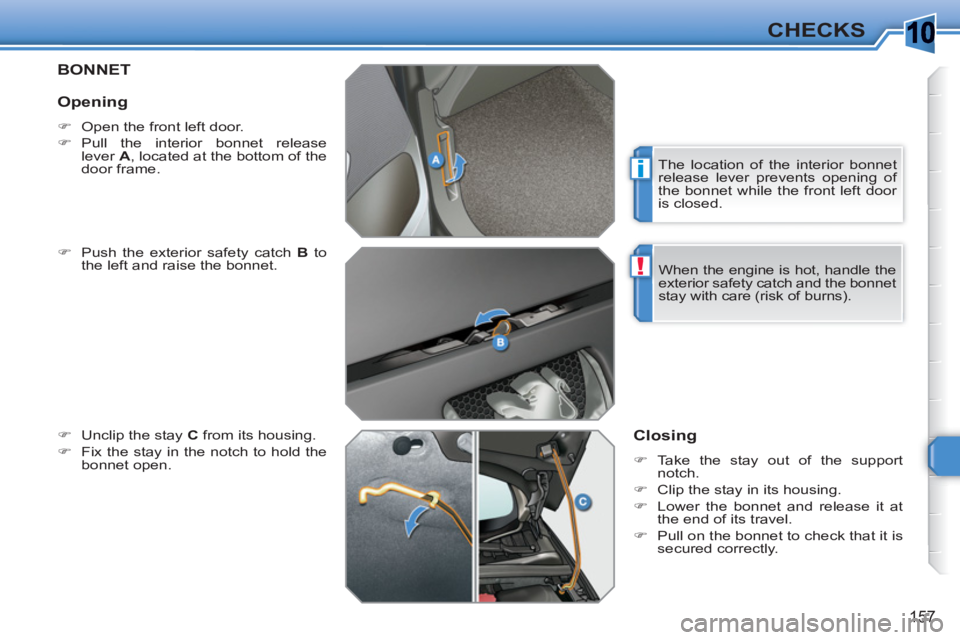
10
i
!
157
CHECKS
BONNET
�)
Push the exterior safety catch B
to
the left and raise the bonnet.
�)
Unclip the stay C
from its housing.
�)
Fix the stay in the notch to hold the
bonnet open.
Closing
�)
Take the stay out of the support
notch.
�)
Clip the stay in its housing.
�)
Lower the bonnet and release it at
the end of its travel.
�)
Pull on the bonnet to check that it is
secured correctly.
Opening
�)
Open the front left door.
�)
Pull the interior bonnet release
lever A
, located at the bottom of the
door frame. The location of the interior bonnet
release lever prevents opening of
the bonnet while the front left door
is closed.
When the engine is hot, handle the
exterior safety catch and the bonnet
stay with care (risk of burns).
Page 160 of 336
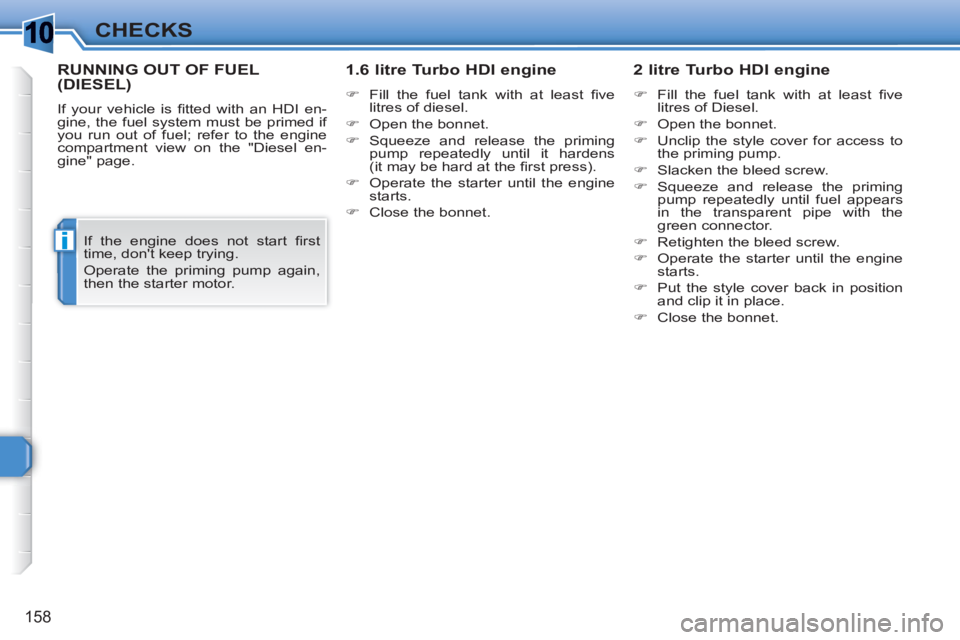
1
i
158
CHECKS
RUNNING OUT OF FUEL (DIESEL)
If your vehicle is fi tted with an HDI en-
gine, the fuel system must be primed if
you run out of fuel; refer to the engine
compartment view on the "Diesel en-
gine" page.
1.6 litre Turbo HDI engine
�)
Fill the fuel tank with at least fi ve
litres of diesel.
�)
Open the bonnet.
�)
Squeeze and release the priming
pump repeatedly until it hardens
(it may be hard at the fi rst press).
�)
Operate the starter until the engine
starts.
�)
Close the bonnet.
2 litre Turbo HDI engine
�)
Fill the fuel tank with at least fi ve
litres of Diesel.
�)
Open the bonnet.
�)
Unclip the style cover for access to
the priming pump.
�)
Slacken the bleed screw.
�)
Squeeze and release the priming
pump repeatedly until fuel appears
in the transparent pipe with the
green connector.
�)
Retighten the bleed screw.
�)
Operate the starter until the engine
starts.
�)
Put the style cover back in position
and clip it in place.
�)
Close the bonnet.
If the engine does not start fi rst
time, don't keep trying.
Operate the priming pump again,
then the starter motor.
Page 161 of 336
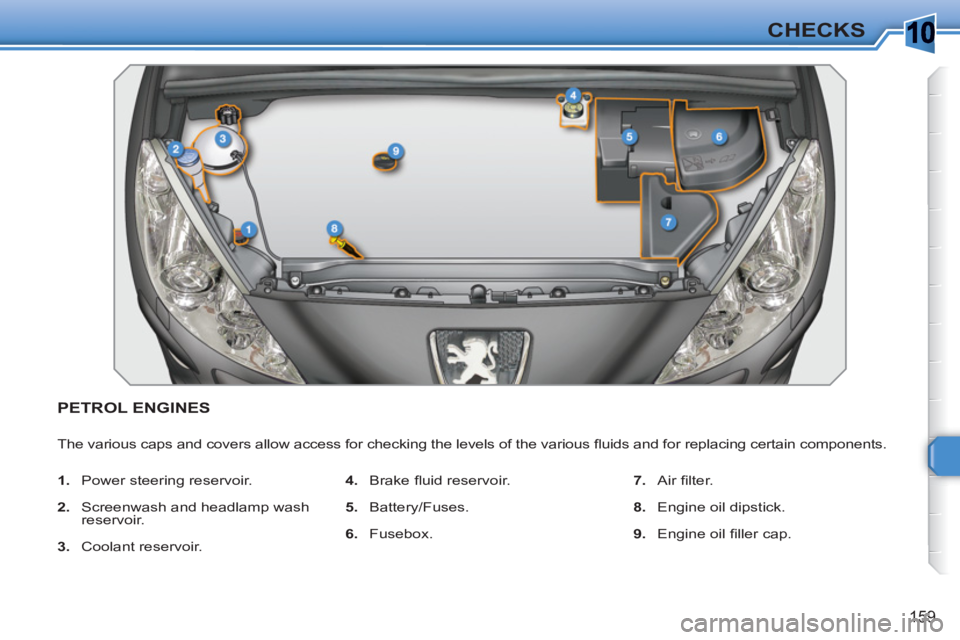
10
159
CHECKS
PETROL ENGINES
The various caps and covers allow access for checking the levels of the various fl uids and for replacing certain components.
1.
Power steering reservoir.
2.
Screenwash and headlamp wash
reservoir.
3.
Coolant reservoir.
4.
Brake fl uid reservoir.
5.
Battery/Fuses.
6.
Fusebox.
7.
Air fi lter.
8.
Engine oil dipstick.
9.
Engine oil fi ller cap.
Page 162 of 336
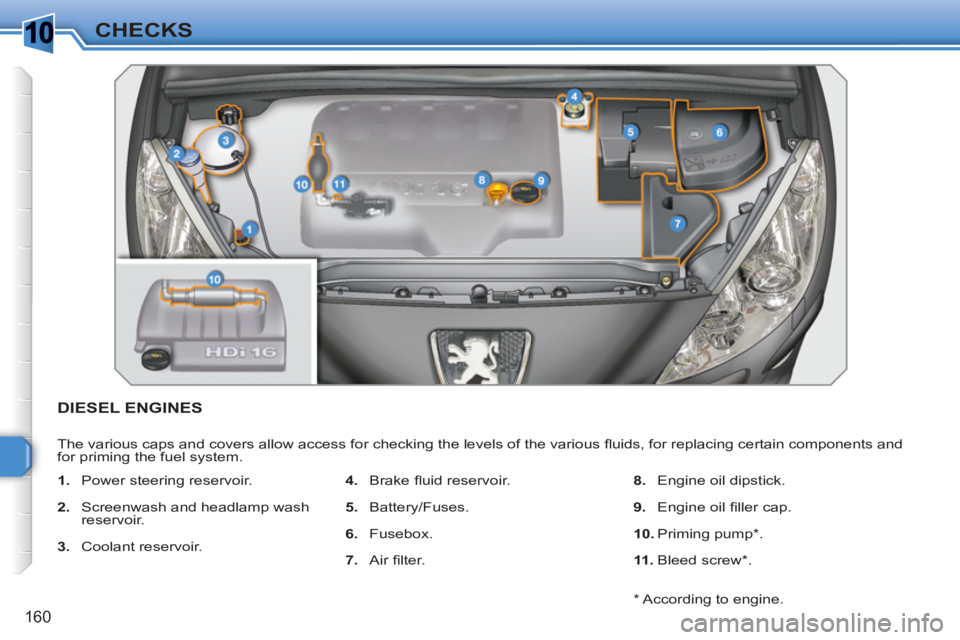
1
160
CHECKS
DIESEL ENGINES
The various caps and covers allow access for checking the levels of the various fl uids, for replacing certain components and
for priming the fuel system.
1.
Power steering reservoir.
2.
Screenwash and headlamp wash
reservoir.
3.
Coolant reservoir.
4.
Brake fl uid reservoir.
5.
Battery/Fuses.
6.
Fusebox.
7.
Air fi lter.
8.
Engine oil dipstick.
9.
Engine oil fi ller cap.
10.
Priming pump * .
11 .
Bleed screw * .
*
According to engine.